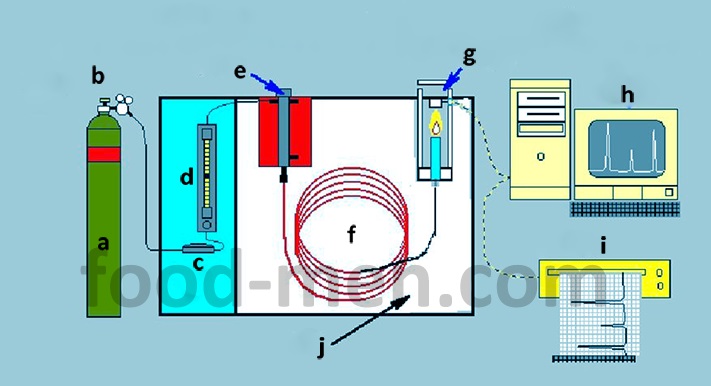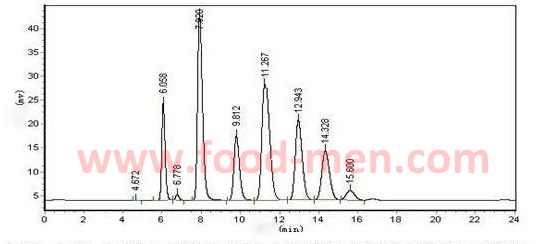Working Principle of Gas Chromatograph
Published date and time: 2020-03-23, 09:28
Date and time of modification: 2022-01-05, 06:20
Author: Food-Men
This article describes the working principle and structure of a gas chromatograph. This is the first part of food safety testing equipment. The gas chromatograph principle is to use a carrier gas to bring the gasified sample into a capillary column, separate the components of the sample, and then detect these components with a detector. Gas chromatographs are commonly used equipment for food safety testing.
Structure and Principle of Gas Chromatograph
As shown below:
 a — Gas cylinder, gas with pressure (carrier gas)
a — Gas cylinder, gas with pressure (carrier gas)
b — Pressure regulating valve
c — Flow controller
d — Flow indicator
e — Sample inlet
f — Column
g — Detector
h — Data processor and computer workstation
I — Recorder and printer
J — Column oven
The gas chromatograph uses a gas as the mobile phase (carrier gas). When the sample is "injected" by a micro syringe into the sample inlet (e), it is carried by the carrier gas into the capillary column (f). Due to the difference in distribution or adsorption coefficient between the mobile phase (gas phase) and the stationary phase (liquid phase or solid phase) of each component in the sample, under the flushing of the carrier gas, the components are repeatedly dispensed between the two phases, so that the components are separated in the column (f). Then, the detector (g) attached to the column is used to sequentially detect the components according to the physical and chemical characteristics of the components; The signal given by the detector for each component is analyzed and processed in the data processor (h). Displayed on the display or recorder is a peak curve, such as the picture on the below, called the “Chromatographic peak”; the maximum value on the chromatographic peak is the basis for qualitative analysis, and the area covered by the chromatographic peak depends on the content of the corresponding component. After a mixture sample is injected, the curve recorded by the recorder is called a chromatogram. We analyze the chromatogram to get qualitative and quantitative results.
 The gas chromatograph has the advantages of high sensitivity, high efficiency, high selectivity, fast analysis speed, and low sample volume. It is a precision analytical instrument with a wide range of applications.
-------------------------------------
The gas chromatograph has the advantages of high sensitivity, high efficiency, high selectivity, fast analysis speed, and low sample volume. It is a precision analytical instrument with a wide range of applications.
------------------------------------- 
